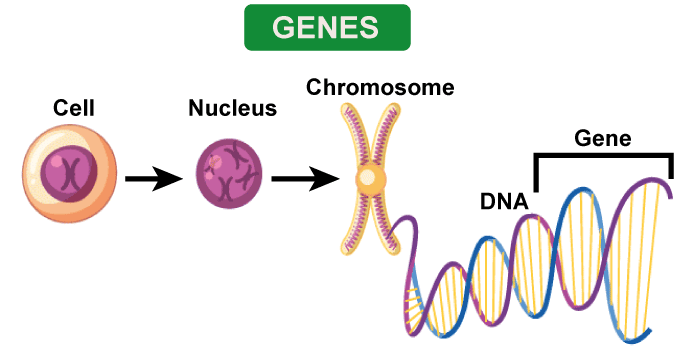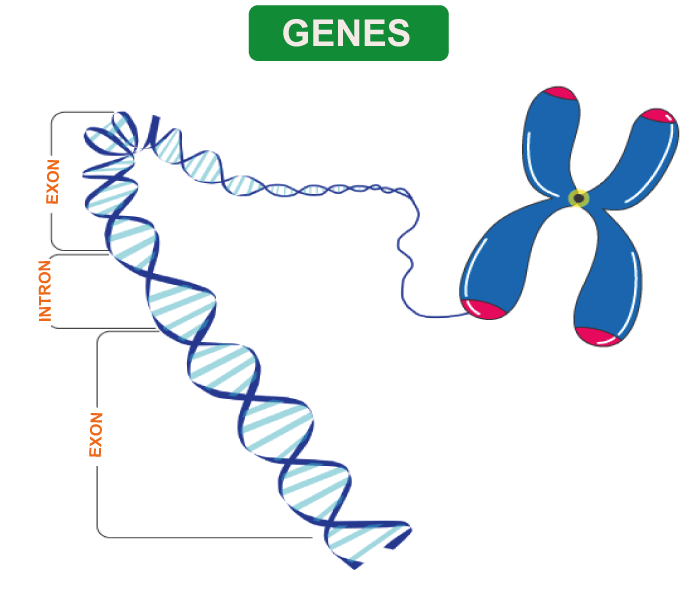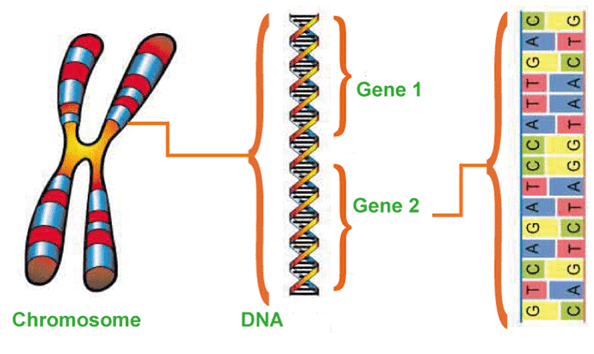Difference between Gene and ChromosomeHeredity is the term used to describe the traits that we inherit from our parents or ancestors. Genetics is the study of heredity. The elements of heredity are DNA, genes, and chromosomes. All of the body's cells have coding information that governs traits inherited from parents. The gene is the most fundamental biological and functional unit of heredity. The component of genes is DNA. Few genes act as blueprints for constructing proteins. Yet, many genes do not code for proteins. Human genes may range in size from a few hundred to more than 2 million DNA bases. Between 20,000 and 25,000 genes are thought to be present in humans, according to the Human Genome Project, a worldwide scientific initiative to map out the human genome's sequence and identify the genes that make up each gene. A chromosome is a neatly structured DNA package that resides in the cell nucleus. There are various numbers of chromosomes in each organism. Humans have 23 pairs of chromosomes; 23 pairs of autosomes and one pair of X and Y or X and X. Children are born with half of their mother's and half of their father's chromosomes since each parent contributes one chromosome to each pair. Histone proteins, which resemble spools, are firmly wrapped around DNA in chromosomes, which have a distinct form. If we draw a straight wire from a DNA molecule, it would be too lengthy to fit inside cells. DNA molecule would measure 6 feet long if freed from their histones and laid end to end. Cells must continuously divide to create new cells to replace damaged, old cells if an organism is to develop and function normally. It's critical for DNA to survive throughout cell division and to be distributed equally across cells. In the majority of cell divisions, DNA is correctly replicated and distributed thanks in large part to chromosomes. Even then, mistakes do happen sometimes. When it comes to storing information, both genes and chromosomes are crucial. There are several genes on each chromosome, and these genes contain the instructions needed to make certain proteins. To understand genes and chromosomes, we first need to understand DNA. 
DNA (Deoxyribonucleic Acid)Two polynucleotide chains make up the molecule known as DNA. These chains are wrapped around one another to create a structure consisting of nucleic acid molecules like DNA. Double Helix is another name for the design. This structure contains the genetic code required for several species' development, growth, reproduction, and function, including viruses. Life cannot exist without nucleic acids like DNA and RNA. Complex carbohydrates, proteins, and lipids are components of essential nucleic acids. Moreover, these acids fall within one of the four primary subcategories of macromolecules. All kinds of life need these nucleic acids; DNA and RNA. What is a Gene?The term "gene" (from the Greek 'genos' means "generation," "birth," or "gender").It may have a number of distinct meanings in biology. The Mendelian gene is the basic unit of heredity, while the molecular gene is a sequence of nucleotides in DNA that are transcribed to generate a functional RNA. There are two types of molecular genes: protein-coding genes and noncoding genes. 
First, RNA is generated from DNA during gene expression. The RNA may carry out a certain function directly or act as a protein's intermediate template. As the genes in certain viruses are comprised of RNA rather than DNA, they may operate without being transcribed into RNA. The transfer of genes to an organism's offspring is the basis for the inheritance of phenotypic traits. Many genotypes, or DNA sequences, are made up of these genes. The genes, together with environmental and developmental factors, influence the phenotypes. The bulk of biological characteristics are regulated by polygenes and interactions between genes and their environment (many distinct genes). It is easy to identify some hereditary traits, such as eye colour or the number of limbs. Others, such as blood type, the likelihood of getting a certain disease, or the many essential metabolic processes that support life, are not easy to identify. A gene's sequence may change, resulting in various alleles or variations, throughout the population. By encoding slightly different versions of the same gene, these alleles may result in slightly different phenotypic characteristics. "Having a gene" is often used to refer to the possession of a particular allele of a single, common gene (e.g., "good genes," "hair colour gene," etc.). Genes evolve as a result of two processes: genetic drift of alleles and natural selection/survival of the fittest. Wilhelm Johannsen, a Danish botanist, plant physiologist, and geneticist, coined the word "gene" in 1909. Genetic CodeThe genetic code is the coding used to determine the protein's amino acid sequence. Each of the three nucleotides that make up the genetic code, or codons, interacts with a particular amino acid. In 1961, frameshift transformation was used to illustrate the idea that each amino acid is coded for by three consecutive DNA nucleotides. The beginning and finish of the protein CDS are represented by a "start genetic code" and three "stop genetic codes." The protein's coding region is another name for the CDS. As there are only 20 amino acids and almost 64 CDS for proteins, the genetic code is meaningless and may indicate the same amino acid. What is Chromosome?A chromosome is a long DNA molecule that houses all or part of the genetic information of an organism. Most chromosomes include packing proteins called histone proteins that protect the very long, thin DNA strands. These proteins condense and adhere to the DNA molecule with the aid of chaperone proteins in order to maintain its integrity. The intricate three-dimensional structure of these chromosomes is essential for regulating transcription. 
Chromosomes are often only visible under a light microscope during the metaphase of cell division (where all chromosomes are aligned in the centre of the cell in their condensed form). Prior to this, each chromosome goes through chromosome duplication (S phase), a process in which a centromere connects both copies, forming either the X-shaped structure (if the centromere is located equatorially) or a two-arm structure (if it is located distally), depending on where it is located. The related copies are now referred to as sister chromatids. The easiest to identify and study is a metaphase chromosome, which is an X-shaped structure that arises during metaphase and is very compacted. In animal cells, chromosomes are most tightly packed during the anaphase phase of chromosomal segregation. Chromosomal recombination during meiosis and subsequent sexual reproduction has a significant impact on genetic diversity. If these structures are treated incorrectly by chromosomal instability and translocation processes, the cell may undergo mitotic catastrophe. The cell will often start the apoptosis process as a result, allowing it to die naturally. But, sometimes, mutations in the cell prevent this from occurring, which advances cancer. Some people use the word "chromosome" in a broader meaning to refer to the distinct chromatin regions in cells, whether or not they are visible under light microscopy. Others use the term more specifically to refer to the distinct chromatin regions that become apparent under light microscopy during cell division as a result of high condensation. Differentiation between Genes and ChromosomesLet us discuss the key difference between a gene and a chromosome in detail.
Next TopicDifference between
|
 For Videos Join Our Youtube Channel: Join Now
For Videos Join Our Youtube Channel: Join Now
Feedback
- Send your Feedback to [email protected]
Help Others, Please Share










